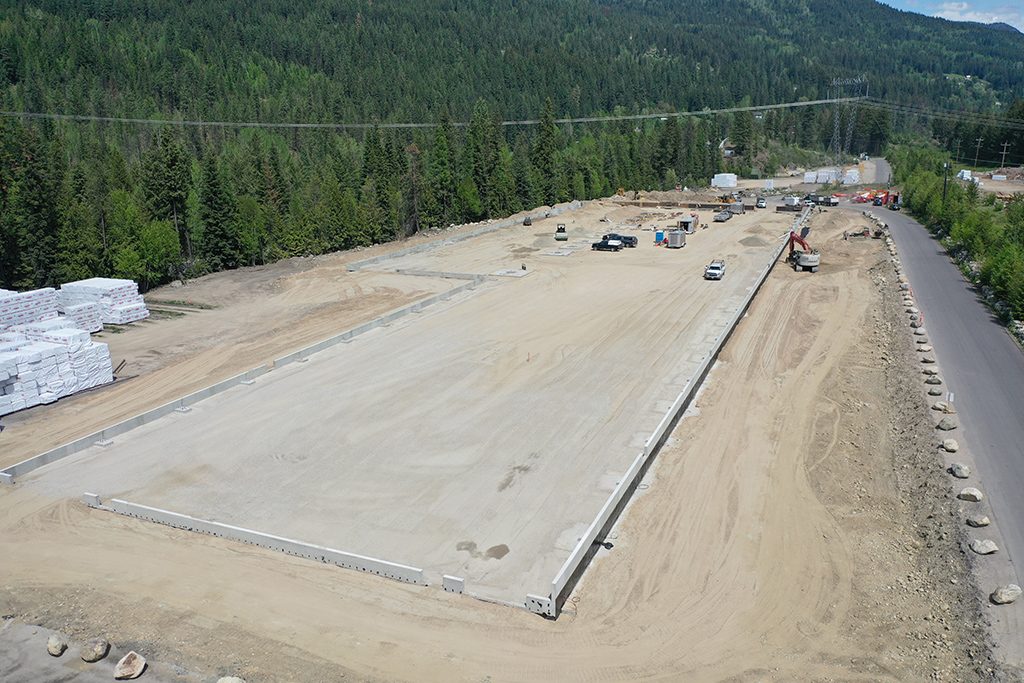Kalesnikoff Lumber, a Kootenay-based lumber plant, is aiming to have its new $35 million mass timber plant begin its operation in early 2020, just prior to the 2020 National Building Code of Canada (NBCC) debut and the advent of 12-storey mass timber buildings across Canada.
“Our building should be up by the end of summer and the equipment arriving in October this year,” said Chris Kalesnikoff, chief operations officer and a fourth-generation member of the founding family. The product line for glulams should be operational by year end.
“We will have our first product (glulam beams) coming off by January 2020. Our cross-laminated timber (CLT) second product won’t come off until spring 2020.”
The two product lines both should be fully operational and have gone through any debugging problems by late 2020 when the NBC debuts. There will also be a finger-joint line.
The last pour for the new plant foundation was completed in mid-May providing a base for the 110,000 sq. ft. steel pre-engineered structure manufactured by Behlen and supplied and installed by Norsteel Building Systems in Kelowna. Assembly begins on May 22 with the arrival of a crane. “We are acting as our own general contractor,” said Kalesnikoff.
Kalesnikoff said the new operation with the European equipment “will be the most technically advanced plant in North America” and able to compete on a global basis. The state of the art equipment is being supplied by companies such as Denmark-based Kallesoe Machinery A/S which is supplying all the high-frequency presses while the finger-joint machine is the product of Canadian-based Conception R.P. Inc., out of Quebec. The new plant, which has a capacity of 50,000 cubic metres of product over two full shifts, is able to produce CLT panels with dimensions of 60 feet by 12 feet and 13 inches in thickness and glulam beams in 60-foot lengths with a width of 12 inches and a 54-inch depth.
The move into value-added product is a natural leap for the company as it has been a glulam “feedstock” supplier to manufacturers in the Pacific Northwest for three decades. Kalesnikoff said the company is known for its ability to kiln dry materials and produce material to “tight tolerances.” It also has the advantage of having one-third of its timber derived from its own timber supply with the remainder coming from timber sales and from private sales or trades.
The region is known for its slow-growing, fine grain timber which yields stronger lumber. The Kalesnikoff Lumber mill has the capacity to produce approximately 75 million board feet of lumber and flexibility is a feature as it can cut 1,000 different products in custom and standard dimensional lumber sizes. Its markets are primarily Canada, the U.S. and Japan.
A key feature is the ability to take a mixture of species that grow in the area as well as the grade of log and direct it into the processing line that yields the highest value, he said.
“We have always chased the value-added product and never followed the normal mill,” said Kalesnikoff. As well as structural lumber, the family owns a specialty product company Kootenay Innovative Wood in nearby South Slocan which produces flooring, moulding, tongue and groove roof decking and softwood panelling.
Kalesnikoff said that B.C.’s lumber supply is not increasing and in order to remain in business for another 80 years, the challenge has become one of looking for market opportunities to add value to the existing fibre basket. Niche markets are one means of capitalizing on opportunity.
For the past five years, Kalesnikoff family members have been looking at mass timber plants throughout Europe and decided to adopt the European model of integration towards fibre utilization. The model works in Europe as these plants have their own timber supply, primary break-down mills and mass timber plants. “You can’t under-estimate the value of an integrated model,” he said.
As the new plant starts operation on a two-shift basis, the immediate market will be B.C. and Western Canada and the U.S. (Mass timber products will be transported mainly by truck but there is rail nearby). However, Kalesnikoff sees a global market in the long term.
Brian Hawrysh, CEO of B.C. Wood Specialties Group, said he is unaware of any Canadian stats on the growth of the mass timber market and its use in construction. But, he called the market increase “significant”, especially in the U.S. where more mass timber plants are also coming on line.
The demand for mass timber in Canada is being fuelled, not by the impending introduction of the new National Building Code and B.C. as an earlier adopter of the code, but by developers realizing that construction can be expedited through the use of mass timbers.
“It is great the codes are catching up to the market place,” Hawrysh said.












Recent Comments
comments for this post are closed